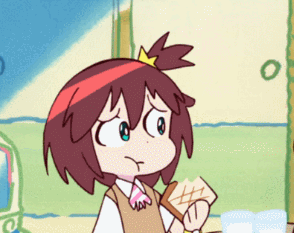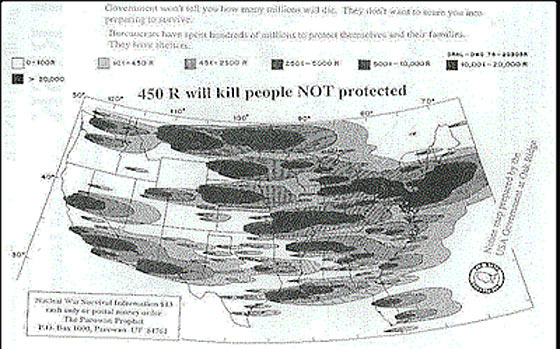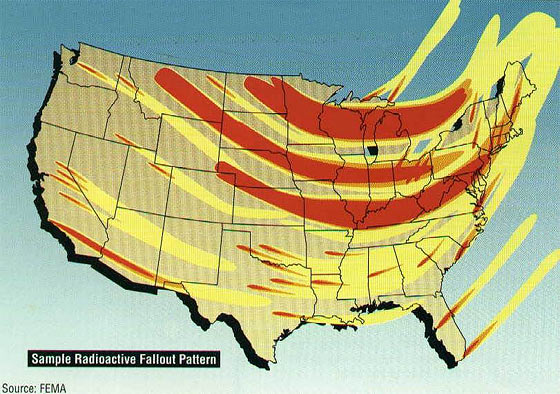August 19, 2018
More News From the World of 'Splody!





Fallout contour for 1 rads per hour:
Fallout contour for 10 rads per hour:
Fallout contour for 100 rads per hour:



We've mentioned Russia's horrific, supersized, Strangeglovian, torpedo of terror here before. Well, the Russian government recently held an online poll to determine what this abomination is going to be named. The winning name was, sadly, not Nukey Mc Nukeface, but Poseidon.
Reports on this system are somewhat contradictory. The Russians seem to be giving 2027 as the date it is fully operational, while it appears that the system is in service now aboard RFS Belgorod, which has the capacity to carry 6 of these devices. The press reports also report that this thing has a yield of 2 megatons, (down considerably from 100MT)but that makes exactly no sense.
Here's why.
Unlike the U.S. the Russians never stopped designing new nukes. They are at least as advanced as us in this regard. In 1963 the U.S. had a one megaton warhead that weighed only 600-680 pounds and was less than 18 inches in diameter. A 21 inch torpedo like the MK 48 has a 650 pound warhead. The Russians use 660mm torpedos. I have no idea what their warhead weight is but the smaller 610mm Japanese Type93 (Long Lance) had a maximum warhead weight of over 1700 pounds in its mod 3 version. Thus one could conceivably put a 1-4 Megaton warhead in their submarine's standard tubes and carry a dozen or more with no expensive mods to the sub. This weapon has been photographed (in its tube) and is bigger than a WW2 Japanese midget sub. Modern 21 inch Torpedoes already have a 140 kilometer range, and one can assume that the 660mm russian weapons are longer legged still, so it seems unlikely that the entire Russian sub force could be stopped from tossing a dozen of these into major US ports, which aren't moving targets after all. This weapon on the other hand is limited to one boat at the moment, with 1 or 2 more in the pipeline. The only reason to add that vulnerability is if there is a huge increase in capability. This blog has explored cratering and seiche effects on a port before. Now let's look at secondary effects.
Belgorod reportedly carries six of these things, What happens if ONE sub fires a full spread and positions them for maximum effect?
Quick! To Nukemap for Justice!


"Holy crap! What the hell am I looking at?"
This is 6 x 100Megaton groundbursts in 5 deepwater ports and a Fishing harbor (Bangor, Astoria, Crescent City, San Fransisco, Sacramento, Long Beach) plus a 2 megaton groundburst for perspective in a salt marsh next to Vandenburg AFB. I had the fallout pattern from the smaller blast go south to make it stand out.
Note that the orange circles are the zone of burnination. At the outer edge of those circles, on a clear day, people outside go blind, get third degree burns, leaves, hair and dark clothing can catch fire, everything inside of that gets steadily more combustible. This means that EVERYTHING inside the inner orange ring is on fire. Recent headlines have implications for that effect, and how hard it might be to get under control.
The light grey bit just inside that is the outer limit of smashed windows and associated lacerations of people who might already be blind and on fire . Damage, gets worse in from that, the darker grey circle on each blast pattern is the 5 PSI limit. The effects of 5 pounds per square inch of overpressure can be seen in this helpful .gif .



(The .gifs on the right actually.)
Everything inside that circle gets progressively more unpleasant. None of those effects save the outer burn limit are visible at this scale on the 2mt bomb, which is the smallest that really shows effects at this scale. Still, I very much would not want to be at Vandenburg in this instance.
I picked the west coast not because I hate J.Greely, and Mauser nor because I think that my home next to the largest naval base in the world is not a target, but because of the orange and yellow pointy bits coming out of the blast radii.
Fallout. This is how the Nukemap site explains the visuals for the streamers coming out of the circles.
Fallout contours for a 100 megaton surface burst (52% fission) with a 15 mph wind:
All of those fall under the category of "bad", with10 rads per hour giving acute radiation syndrome in about half a day.
The fallout contours vary in length because I varied the wind speed. The mushroom cloud from a full yield RDS-220 is estimated to get over 30 miles high so it's going to be blown east by high speed upper level winds, especially if it intersects the very high speed winds of the jet stream(s). The wind speeds in the above image vary from 10mph to 180mph.
In practice such fallout patterns would follow a lazy s curve well into Canada (I would not want to be in Saskatoon or Winnipeg) before arcing down intothe U.S. breadbasket and possibly (depending on wind speed) looping up through the northeast and poisoning New England & the Maritimes. This is, of course highly dependent on the time of year (things like is the subtropical jet stream active as well as effects of North America's comparatively mild continental Monsoon pattern).
Here for comparison are three different fallout estimates from the federal government.



Images all nicked from Modern Survival Blog.
Note that these all date from the '80s or earlier and are all based on cold war scenarios involving a thousand or more bombs. The estimate in the first image is for 6.
So a full spread of 6 high yield weapons from Belgorod killed or poisoned at least half of North America and probably killed a majority of Canadians as an afterthought. That is a capability that makes the huge scale and complexity of this system actually make some sense, in exactly the same way that the 2megaton yield being reported doesn't.
I strongly suspect that IF this is not a Potemkin torpedo, that the yield is much higher than the 2 megatons that has been surfacing in news reports lately. I'm sticking with between 50 and 150 megatons.
Note too that 150MT was, according to The Johnston Archive, the final maximum design yield for the RDS-220 physics package, when it was intended as a warhead for the ICBM that was re-purposed as the Proton launcher.
Even given space and weight restrictions in the torpedo, 100 MT doesn't seem unreasonable. It seems like a middle of the road estimate.
If you take the parachute, and lay down casing off the old, 1963 Tsar Bomba the actual 'splody bits should just fit into a Poseidon. That weapon fit into the T-15 torpedo designed for it with just fine and its dimensions are similar to Posiedon's (albeit it was a tad shorter). It's been a long time since 1963...a lot of progress has been made.
Nuclear war is hideous to contemplate, but we lived unbder its spectre for decades. However, 'total atomic anihilation' used to require hundreds or even thousands of warheads. An EMP is a real threat, but doesn't involve direct damage or any meaningful fallout. Of course, in the unlikely event they ever use these things then the Russians will be hitting us with everything they have. Even if only to make the rubble bounce.
So.
Contingency plans.
Ceres vs. Mars?
Pro's and cons.
Discuss....
Posted by: The Brickmuppet at
08:10 AM
| Comments (5)
| Add Comment
Post contains 1270 words, total size 14 kb.
<< Page 1 of 1 >>
37kb generated in CPU 0.0655, elapsed 0.1494 seconds.
67 queries taking 0.1306 seconds, 214 records returned.
Powered by Minx 1.1.6c-pink.
67 queries taking 0.1306 seconds, 214 records returned.
Powered by Minx 1.1.6c-pink.









